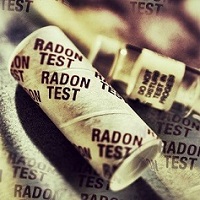Test Your Home to Determine Risk of Radon Gas Exposure
You can’t see it, smell it or touch it.
The #1 cause of lung cancer outside of smoking is a radioactive gas that everyone breathes in every day, usually at low levels, according to the National Cancer Institute.
Radon gas is produced from a natural breakdown of uranium in soil, rock and water. This radioactive gas can be detected in homes, offices and schools; it enters buildings through cracks in floors and walls, construction joints or gaps around service pipes, electrical wires and sump pits.
When radon gas exceeds acceptable levels, the result can be deadly.
Scientists estimate 15,000 to 22,000 lung cancer deaths in the U.S. each year are related to radon.
People who breathe in radioactive particles, swallow water with high radon levels or are exposed to radon for a long period of time are susceptible to lung damage and lung cancer. The Environmental Protection Agency says nearly 1 out of every 15 homes in America is estimated to have elevated radon levels.
How Do You Know if You’re at Risk?
The EPA reports elevated levels of radon gas have been measured in every state. Everyone is at some risk. Smokers who are exposed to elevated levels of radon gas are at higher risk of developing lung cancer.
Testing is the only way to determine how much radon is present in your home or drinking water. Short-term (3- to 4-day) and long-term (3- to 12-month) test kits are available. In some cases, manufacturers of these kits will conduct analysis and post results online.
How to get a free radon test kit?
Call the Kentucky Radon Program at: (502) 564-4856.
How Much is Too Much?
No level of radon exposure is considered completely safe, however the EPA only recommends reducing radon levels in your home if your long-term exposure averages 4 picocuries per liter (pCI/L) or higher. A pCI is a measure of the rate of radioactive decay of radon gas. (These are the tiny particles that can get trapped in your lungs when you breathe.)
Reducing Radon Gas in Your Home
The American Cancer society says a variety of methods can be used to reduce radon gas levels in your home, including sealing cracks in floors and walls and increasing ventilation though sub-slab depressurization using pipes and fans.
The EPA recommends using a state or nationally certified contractor because lowering high radon levels often requires technical expertise and special skills. Two agencies have set the standard for participants seeking certification:
January is National Radon Action Month
The U.S. Environmental Protection Agency has designated January as National Radon Action Month, a time when health agencies across the country urge all Americans to have their homes tested for radon. Schools, businesses and other buildings also should be tested, according to the EPA.
Visit the EPA website for ideas on how to help spread the word about Radon testing and mitigation.
What is Being Done to Protect Employees
The Nuclear Regulatory Commission and OSHA set limits on exposure to radon in the workplace.
In mines, one of the most dangerous areas for radon exposure, features have been added to lower radon levels. For uranium miners, millers and transporters who have certain health problems as a result of exposure during atmospheric nuclear weapons tests or while employed in the uranium industry during the Cold War arsenal build up from 1945 to 1962, the U.S. government has established the Radiation Exposure Compensation Act.
Other Resources
- Agency for Toxic Substances and Disease Registry
- Department of Justice
- Environmental Protection Agency
- LCDHD Radon Page
- National Cancer Institute
On a separate note, it is important to point out that Kentucky is one of the unhealthiest states in our nation; but, a few healthy lifestyle choices could change this. First, eating normally proportioned helpings of nutritious foods including at least five fruits and vegetables a day can lower weight and reduce heart disease and diabetes. Second, exercising about 30 minutes per day can lower blood pressure. Third, avoiding the use of tobacco products can reduce several types of cancer. Finally, making sure you get your needed preventive screenings can detect diseases early and greatly increase your chances for a positive health outcomes, while receiving your recommended vaccinations can prevent acquiring disease in the first place.








